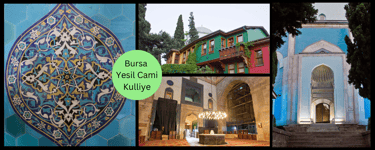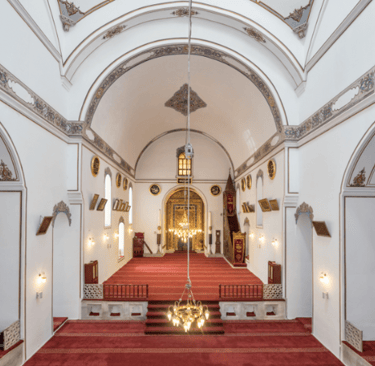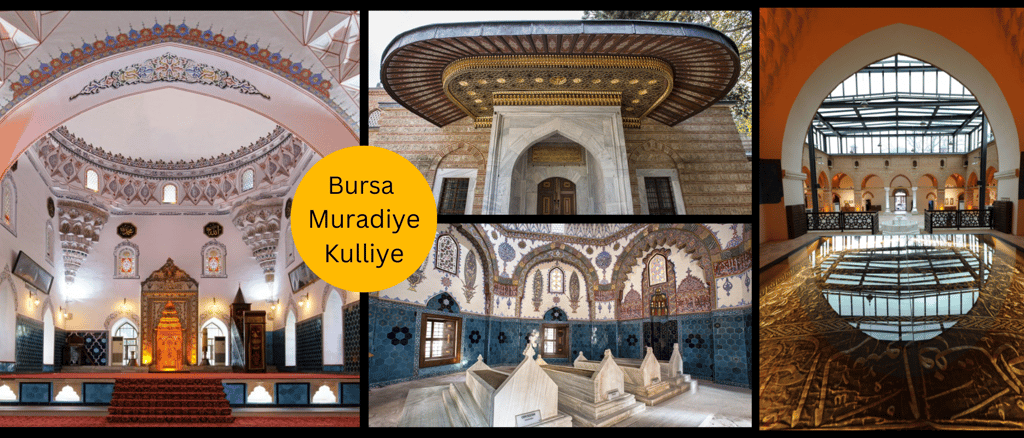Bursa Sultan Kulliye Complexes
The Külliye complex is a community of structures formed by bringing religious and social structures together around the mosque...
SPIRITUAL & RELIGIOUS BURSAHISTORY, ART & CULTURE
8 min read
Bursa Sultan Kulliye Complexes
Green Külliye Complex aka Sultan Çelebi Mehmet Külliye Complex
The complex was built by Sultan Çelebi Mehmed, the fifth sultan of the Ottoman Empire, in a dominant point between the city center, Yıldırım Complex, and the city center. After the death of Yıldırım Bayezid, construction started after the period of the fetret, which lasted about 11 years.
The complex, symbolizing the re emergence of the Ottoman State, consists of structures with the richest ornaments among Ottoman architectural works. It includes a mosque, tomb, madrasa, Turkish bath, and imaret. Today, the madrasah serves as a Turkish Islamic museum, and the Turkish bath serves as a shop selling souvenirs.
It is a religious and social center formed by a few madrasahs, muvakkithane*, tombs, soup kitchens, hospitals, fountains, bazaars, and similar structures established with a mosque.
*Muvakkithane is the place where prayer times are determined according to the movement of the sun, and small astronomy studies are performed.


Green Tomb
The Green Tomb was built for Çelebi Mehmed and is known for its green and turquoise relief tiles that adorn its facades. It was built in 1421 by Çelebi Mehmed, the son of Yıldırım Beyazid and the fifth of the Ottoman sultans. Çelebi Mehmed is considered the second founder of the Ottoman State. In his 34 years of struggle-filled life, he participated in war 24 times and was wounded in 40 different places on his body. The construction of the Green Tomb was completed 40 days before his death. In the tomb, Çelebi Mehmed, his daughters Selçuk Hatun, Hafsa, Ayşe, Sitti Hatun, his sons Mahmud and Yusuf, and their nannies are buried.
The Green Tomb's elevated location compared to the Green Mosque is unusual. The reason it is higher is to convey the message "we are standing" against the enemy during the difficult period of the Ottoman Empire. After the defeat of the Ankara war and the power struggle between the brothers, the Green Tomb was made flashy to show that Çelebi Mehmed's Ottoman did not collapse and that he could create brighter works than before. The Green Tomb is the only mausoleum in Ottoman architecture with all its walls covered with tiles, named so because it is covered with green and turquoise-colored tiles.
The tomb, appearing as a single floor from the outside, is two-floored with the hall where the sarcophagi are and the cradle-vaulted burial chamber below it. Padisah Celebi Mehmet's chest was completely covered with tiles. Additionally, the outer walls are covered with turquoise tiles. The interior of the tomb, including sarcophagi, altar, walls, sentence door, and facade coverings, is also adorned with tiles. The altar facing the Qibla is a work of art, with the tiles here being masterpiece examples of Iznik tile making.
Yesil Cami
The mosque, located in the Yeşil district, was built in 1419 by Sultan Çelebi Mehmed. The Green Mosque, with an inverted T planned structure, is one of the most beautiful historical buildings in Bursa and Turkey. The crown gate at the entrance of the Green Mosque is one of the most special examples of Turkish stone carving. Green stone and marble are used in the door arch. There are two windows on the left and right sides of the stone door, with an outer altar between them, showcasing very intricate stone craftsmanship. Most of the mosque is covered with an artful wonder of tiles.
One perfect example of tile craftsmanship in the mosque is its altar, which is more than ten meters high. The mihrab, with flowers and various geometric motifs, is one of the mosque's most beautiful features. The mihrab, indicating the direction of the Kaaba, is located on the wall in that direction and shows where to stand during prayers.
In this mosque, you can find the best examples of woodworking in Bursa. Window covers are a testament to the period's excellent woodworking. Unlike other mosques, there are very fine ornaments in its domes. The mosque also boasts a beautiful fountain made of a single piece with unique beauty.
The famous Turkish traveler Evliya Celebi stated that the dome and minaret of the mosque were covered with green tiles in the second half of the 1600s. At that time, some foreign historians and travelers mentioned that the Green Mosque was perhaps the best work of the Ottoman reign.
How to reach the Green Külliye:
Transportation can be easily provided by minibuses going to the Yeşil/Emirsultan district from the minibus stops behind the Atatürk statue in the center of Bursa. It is next to the Green Mosque and the tomb, a 5-minute walk from the Irgandi bridge, and a 15-20 minute walk from the center.
Murad Hüdavendigar Külliye Complex
It is in the Çekirge District, the hot spring and healing center of Bursa since Roman and Byzantine times.
1. Murad Hüdavendigar Mosque
Built by Sultan Murad I in 1365-1366 in the Çekirge district on a hill overlooking the plain. The lower floor was arranged as a mosque, and the upper floor was designed as a madrasa, applying a different style in terms of functionality. When you enter the mosque, it appears as a single-story building. The rooms built for madrasah students on the upper floor are not visible from inside. The two-storey portico application in the mosque is unique and cannot be seen in any other mosque.
1. Murad Hüdavendigar Tomb
Built by Yıldırım Bayezid in 1389. It has the same plan as Orhan Gazi's tomb. The entire tomb was destroyed in an earthquake in 1854, and the present tomb was built on its foundation.


How to get to 1. Murad Hüdavendigar Tomb
You can go with the Çekirge buses and dolmus cars departing from Heykel, Setbaşı, and Altıparmak. After you get off at Çekirge Square, it is 200 meters away.
The last complex built by the Ottoman sultans in the heart of Bursa. The construction, completed in 1426 by the sixth Ottoman sultan Murad II, The complex encompasses a mosque, madrasa, Turkish bath, hospital, and tombs, reflecting the multifaceted role of külliyes in Ottoman society. Bursa Muradiye Kulliye complex is a testament to Ottoman architectural brilliance and historical richness.
Muradiye Külliye is home to 12 separate tombs belonging to the Ottoman dynasties. Tombs built during the reigns of Fatih Sultan Mehmed, Bayezid II, and Suleiman the Magnificent were added to the Muradiye Complex.
Muradiye Külliye Complex
A testament to Ottoman Architectural Grandeur


Sultan Murad II, the visionary behind the külliye, finds eternal repose here, alongside notable descendants such as Sultan's son Mustafa, Sultan's son Mahmut, and Cem Sultan. The külliye's oldest mausoleum, erected by Fatih Sultan Mehmed in 1449 for his mother Hüma Hatun, adds a layer of historical significance to the complex.
As time unfolded, subsequent rulers contributed to the külliye's evolution by constructing additional tombs, transforming it into a communal resting place for Ottoman dignitaries. The complex now houses a total of 40 Ottoman dynasty members, each tomb telling a unique story of Ottoman heritage.
The tombs within the külliye vary in complexity, with some adorned with impressive tiles, showcasing the artistic richness of the Ottoman era. Noteworthy among them is the mausoleum built by Sultan Selim II in 1574, dedicated to his brother Şehzade Mustafa, who passed away in 1553.
The construction of these tombs spanned different years, creating a captivating community of tombs with distinctive architectural and decorative features. Exploring the Muradiye Külliye Complex offers visitors a journey through Ottoman history, where each tomb is a chapter in the empire's rich narrative.
Muradiye(Murad II) Mosque,
A central element of the complex completed in 1426, boasts a simple plan yet rich exterior and interior ornamentation. The mosque's architectural grandeur is further enhanced by its intricate tile work, exemplifying the mastery of Iznik tile craftsmanship.
Tomb of Murad II,
Located in the southwest of the mosque, holds a unique feature—a dome left open to allow rainwater to reach the grave, symbolizing a connection with the divine elements. The tomb's simplicity contrasts with the more elaborate tombs, such as those of Cem Sultan and Sultan's son Mahmud, showcasing the diverse styles within the külliye.
Muradiye Quran and Manuscripts Museum
Once a madrasa(one of the important educational institutions of the Turkish-Islamic geography), now houses an extensive collection of manuscripts and calligraphy. Each room presents a visual journey through different periods, allowing visitors to appreciate the intricate artistry of Qur'anic texts.
The Muradiye Külliye, with its architectural diversity and historical significance, serves as a cultural and educational hub. It stands as a living testament to the Ottoman Empire's rich heritage, inviting visitors to explore the intersection of art, history, and spirituality within its hallowed walls.
Yıldırım Külliye Complex
Built on a hill overlooking the Silk Road in the east of Bursa, this complex initially included a mosque, madrasah, bathhouse, imaret, inn, barn, well, and hospital within its walls. Today, only the mosque, Turkish bath, madrasah, hospital, and tomb remain. Architectural and artistic elements in the Yıldırım Complex are evidence of the Ottoman transition from a small principality to a worldwide empire, showcasing firsts in Ottoman architecture.
Yildirim Mosque
Built by Yıldırım Bayezıd at the beginning of the 14th century, this mosque is a unique example of iwans on both sides and mosques with an inverted T plan. The monumental entrance facade, made of cut stone and rising over two floors with Bursa arches, was created here for the first time. Although the original minarets were destroyed, the present minaret was built in the 1960s.
Yıldırım Madrasah
Built in the 14th century, it has a privileged place among early Ottoman madrasahs. It features the classical Ottoman madrasa style, with classrooms and iwans around the middle garden, serving as the first Ottoman madrasah with a garden. Today, it serves as a dispensary.
Yıldırım Darüşşifâ / First Ottoman Hospital
Built by Yıldırım Bayezid in the late 1300s, it is the first hospital of the Ottoman Empire. Darüşşifa served as a foundation hospital, offering free treatment. Today, it continues to function as an eye hospital.
Yıldırım Bayezid Tomb
Built in 1406 by Emir Süleyman, the son of Yıldırım Bayezid. The tomb pioneered Ottoman mausoleums, featuring a portico for the first time. In addition to Yıldırım Bayezid's chest, the tomb houses the chest of his son İsa Çelebi.
Orhan Gazi Complex and its surroundings / Hanlar region
Built by Orhan Bey in 1339-1340, the complex includes a mosque, madrasa, imaret, school, Turkish bath, and Emir Inn. It is located east of the Great Mosque and is one of the first examples of Ottoman complexes.
After the conquest of Bursa, Orhan Gazi built a complex just outside Bursa Castle in line with the policy of developing the city. The Orhan Gazi Complex, initially planned to include an inn structure (Emir Han), has turned into the Historical Bazaar and the Hanlar Region, the city's commercial center over time. Historical buildings in this region were constructed from the 14th century to the 16th century.
Orhan Bey Mosque
Built in 1339 by Orhan Gazi, the mosque is one of the most important buildings of the early Ottoman period in Bursa. It is next to the park with the pool next to the Great Mosque. Orhan Mosque is the first mosque in Bursa with an angled plan type. Twin arches on the sides are important features of the building. Orhan Mosque is built with three rows of bricks and a row of stones, and the brickwork on the exterior is worth seeing.
Emirsultan Mosque
Emir Sultan Mosque, one of the most important architectural structures of Bursa, is located within the borders of Yıldırım district. It is situated between the cypress and plane trees next to the “Emir Sultan Cemetery” in the neighborhood of the same name in the east of Bursa. It was built at the beginning of the 15th century by Hundi Hatun, the daughter of the 4th Ottoman Sultan Yıldırım Bayezit and the wife of Emir Sultan after the death of Emir Sultan. The traces of the Ottoman baroque style can be seen in all the architectural details and carved decorations inside the mosque. The pulpit of the mosque is decorated with Iznik tiles.
Next to the mosque, there is a bathhouse and tombs belonging to Emir Sultan and his family.
